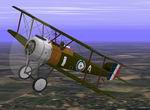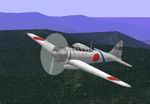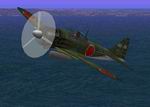 |
|
Home
| Search
| Forums
| Help
| Upgrade
to Premier Membership
|
|
CFS
Home
CFS
2
CFS
1
Utilities
Links
Upgrade
to Premier Membership
|
 Aircraft
page 29 Aircraft
page 29 |
 |
| Australian
SOPWITH CAMEL
February 2003 A.F.Scrub This is the Sopwith Camel D1929 flown by Arthur
Cobby during June of 1918. Cobby claimed 12 victories in D1929 comprising
two in May and ten in June of 1918. Cobbys 13th victory was of Uffz
Max Mertens on June 19th. The Camel was First flown on May 17, 1917,
and was the Allies premier fighter in WWI. The "Camel" demonstrated
good handling and its armament of two 7.62 mm Maxim or two Vickers
0.030 machine guns was formidable. The name "Camel" was derived from
the hump-shaped cover over the machine guns. 273K |
|
 |
| Replacement
pack of He111 textures and a He111 raid on London.
Improved textures for default He111 and its' flyable relatives. Featuring
a realistic glazed cockpit nose. Versions are day and night bombers,
Russian winter, summer, desert and an improved default version. Also
includes details on various flyable He111s available and an air-raid
mission on London. Arno Brooks. 145K |
|
 |
| Mitsubishi
A6M2 Zero flown by Saburo Sakai of the Tainan Naval Air Corps,
Imperial japanese Navy Air Force; Lae, New Guinea, July 1942. Saburo
Sakai achieved 60 aerial victories while flying the A6M2, before being
severely wounded in the Guadalcanal campaign and giving up operational
flying for many months. After the war, Sakai was the only one surviving
Japanese ace, and wrote his experiences on the known book "Samurai",
a masterpiece of aeronautical literature. Original designer: Terry
Hill Flight model: Bruno Duffort Original Panel: Mike Colclough (Zero
A6M5) New textures, guns profile, modified panel: Edmundo Abad. 317K |
|
 |
| Messerschmitt
BF 109 G-14 of the Italian ANR for CFS1.
This is a reworking of the textures of the Bf109G-14 for CFS1 by Pentti
Kurkinen. The plane now represents the "Black 7" flown by Cap. Ugo
Drago, CO of 4a Sq., II° Gr.Caccia, ANR, Northern Italy, in Winter
1944/Spring 1945. Cap. Drago is an Italian ace with at least 17 confirmed
air kills, still living. 560KB. By: Corrado Sandri. 434K |
|
 |
| CFS
Aircraft Kawanishi E7K2
(Type 94-2) "ALF" for Combat Flight Simulator 1. By Edmundo Abad.
Original FS98 aircraft, converted to CFS1 with new panel, damage profile
and textures. Kawanishi E7K2 ALF Imperial Japanese Navy 'Kawanishi
E7K2, Type 94-2' reconnaissance seaplane since 1938. Original Designer:
'flyman' Yusaku Honma/1997. 90K |
|
 |
|
 |
| CFS
Aircraft Kawasaki Ki-45 Toryu
for Combat Flight Simulator 1. By Edmundo Abad. Original FS98 aircraft,
converted to CFS1 with new panel and repainted textures as 2nd Chutai
(Squadron or company) 4th Sentai (flight regiment) plane, Japanese
Army Air Force. The 4th Sentai was credited with 150 american bombers
shot down, reaching the best score with the KI-45. Original design
for FS98: 'flyman' Yusaku Honma. Repainted textures, modified damage
profile, and air file: Edmundo Abad. 73K |
|
 |
| CFS
Aircraft Mitsubishi A6M5c Zero "Takeo Taminitzu" for
Combat Flight Simulator 1. © Edmundo Abad, May 2003 Mitsubishi A6M5c
Zero flown by Naval Air Pilot Takeo Tanimizu of the 203rd Fighter
Group, Kagoshima, June 1945, Imperial japanese Navy Air Force (featuring
his stylistic B-29 kills on the rear fuselage). Original Designer:
Bruno Duffort (Zero A6M5a). Original Panel: Mike Colclough (Zero A6M5a).
Conversion with new panel, new gunstations (4x12.7mm + 2x20mm), damage
profile and textures by Edmundo Abad. 549K |
|
 |
| CFS
Aircraft Mitsubishi A6M2n Rufe
for Combat Flight Simulator 1. © Edmundo Abad. Nakajima A6M2n Rufe.
Original FS98 aircraft, converted to CFS1 with new panel and repainted
textures as 5th Air Fleet plane, Aug-Nov 1942, Kiska Island, The Aleutians.
318K |
|
 |
|
 |
| CFS
Aircraft Mitsubishi Ki46-III_KAI
for Combat Flight Simulator 1. FS95 aircraft, converted to CFS1 with
new panel, gunstations and repainted textures. The Mitsubishi Ki46
Dinah, fighter version, called "Hyakushiki Shitei III-Kai (Dinah)"
was a development of the Ki-46-III Reconnaisance Aircraft, with cameras
deleted, though it reverted to a more conventional cockpit canopy
arrangement, as the nose had to be fitted with twin Ho-5 20 mm. cannon
with 200 rounds per gun. An Ho-203 37 mm. cannon with 200 rounds capacity
was placed in a fixed mounting on the top of the aircraft to fire
upward and forward at an angle of 60 degrees from the horizontal,
similar to "Schrage Musik" weapons in German night fighters. Original
Designer for FS95: Herve Devred/1996. Panel: I used the panel of BF110
made by Jody 'Psiico' O'Brien/1999 (included). Repainted textures,
modified damage profile, and air file: Edmundo Abad. 231K |
|
 
|
|
|
| |











